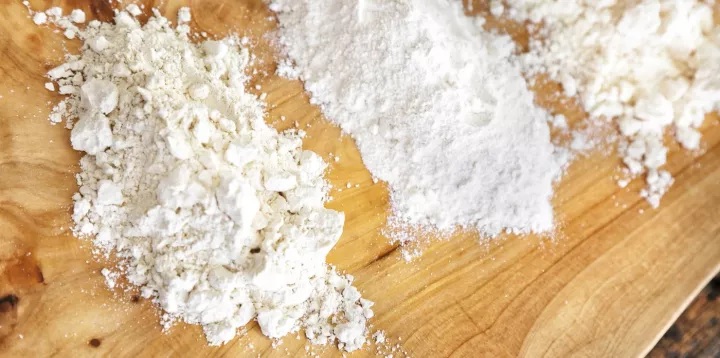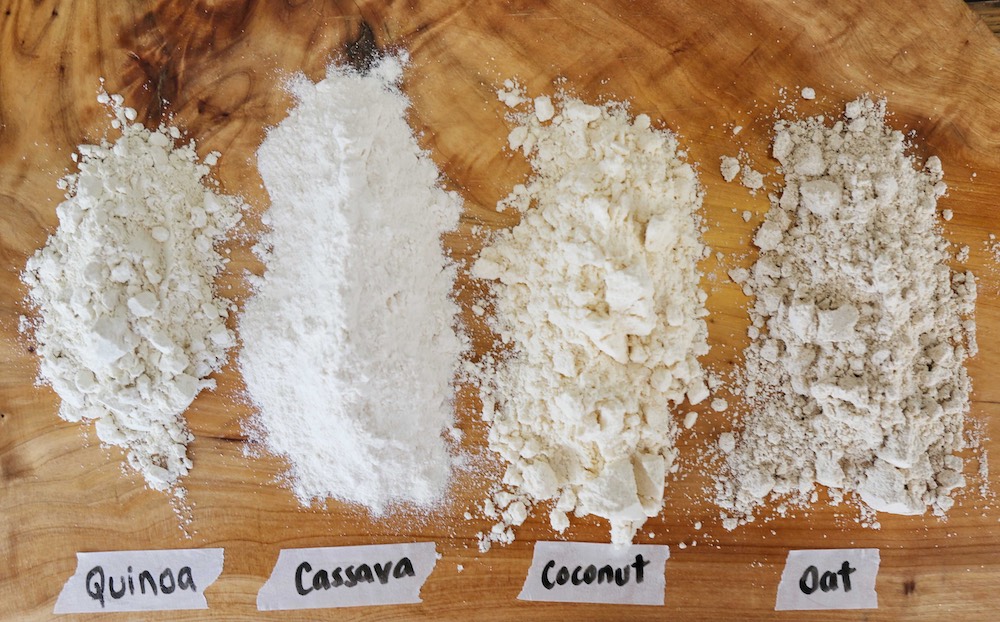
Four More Flour Alternatives
You can make gluten-free flour with nuts, seeds and even root vegetables.
In 2019, we explored chickpea flour, rice flour, almond flour and buckwheat flour at ICE. We work with many alternative flours and our readers have requested more information on oat flour, quinoa flour, coconut flour and cassava flour.
Gluten-free flours and nut flours for cooking and baking have been on the rise because of versatility, health benefits and viable options for people with celiac disease or other dietary restrictions.
Types of Flour
All-purpose flour alternatives are made with gluten-free ingredients like grains, seeds or nuts and can be substituted in recipes for nutritional value, dietary guidelines or to eliminate gluten altogether. Unfortunately, there is not an equal substitute for wheat flour or all-purpose flour, which has the protein gluten, but there are other sources of protein that can be made into flour that fares well when baking or cooking.
The weight, texture and makeup of alternative flours vary and recipe substitutions require a blend of flours, starches, binding agents or stabilizers to achieve the texture derived from gluten. In addition, baking temperatures, liquid ratios and mixing all need to be adjusted when swapping all-purpose flour for an alternative flour.
Store-bought gluten-free flour blends are not as reliable due to the variety of flours mixed that cause inconsistency in recipes. It is easy to make a blend at home to fit individual taste preferences, and a homemade flour blend can be more consistent. It's important to weigh out ingredients on a scale by volume and use proper substitution conversions for precision and consistency.
Buying vs. Making Flour
Alternative flours can be expensive, especially for a single recipe. However, making your own at home is inexpensive and as simple as using a high-speed blender. If you have a food processor, use a mesh strainer to sift and separate coarse flour from fine. Begin with buying quality ingredients that are organic and free of allergens, and avoid cross-contamination. Bulk bins are a fantastic way to buy high-quality ingredients in small amounts, but if you need a certified gluten-free flour or recipe you are better off buying ingredients that are sold in air-tight packages. Store your own extra flour in air-tight jars for later use.
Storing Flour
Alternative flours made with grains, seeds or nuts may have higher oil content that makes them prone to spoil easily when temperatures fluctuate. A small batch of homemade flour can be stored at room temperature, but large amounts should be refrigerated in an airtight container or freezer to increase shelf-life.

Oat Flour
Oat flour is made from grinding rolled oats, which are naturally gelatinous. The flavor of oats is mildly nutty and enhanced by toasting before making the flour. Rolled oats are good for baking, high in protein and fiber and low on the glycemic index. The texture of oat flour is rougher than regular flour, but the creaminess makes it a great swap for breakfast recipes and bread. South Indian breakfast recipes, like idli made with rice, can incorporate oat flour nicely. Not all oats are gluten-free. Check the nutrition label for certified gluten-free oats. Oat flour is ideal for making bread.
Quinoa Flour
Quinoa grains are tiny edible seeds that belong to the amaranth family and are high in protein and fiber. Quinoa flour is popular for its high protein content, which makes it versatile for cooking, baking or using as a protein powder substitute. It can be bitter in large amounts so be sure to test your recipe and make flavor adjustments to your taste. The consistency of quinoa flour is similar to all-purpose flour and can be used as a thickener.
Use quinoa flour to batter onion rings, chicken or in any savory recipe that needs a breaded coating. Like oat flour, quinoa substitutes well for Indian porridge recipes or rice. Quinoa grains have a unique herbaceous smell. Toasting can minimize this smell and bring out more of the nutty flavors instead. Quinoa flour has a better absorption than other alternative flours and works well for baking. The high protein content of quinoa flour is perfect for bread recipes.
Study Pastry & Baking Arts at ICE.
Coconut Flour
My personal favorite is coconut flour. It does have a coconut flavor when not combined with other flours. Coconut flour is naturally fatty from the grated mature coconut flesh that’s dried and ground into flour. Coconuts are the largest nuts, and the flesh or meat when dried and pulverized resembles white all-purpose flour. The flesh of coconut meat is denser because of the coconut water and retains more liquid than other flours. Coconut flour is high in fiber and low in carbohydrates.
The coconut flesh is versatile for savory curries or baking. The natural sweetness of coconut flour pairs well with common ingredients used in baking. Like many gluten-free flours, coconut flour can be used as a substitute for wheat flour; however, the ratio of flour to liquid has to be adjusted. Coconut flour is gluten-free, so doughs made with coconut flour need to be mixed longer. For baking, reduce the all-purpose flour to a quarter. For most other flours, for every 1/4 cup of coconut flour add an egg or leavener for moisture and structure.
Cassava Flour
Casasva is free of grains, nuts and gluten. Cassava flour is starchy and gluten-free made from the tuberous root vegetable that’s dried and ground into a bright white flour. Cassava root, known as yuca, is high in fiber and vitamin C while low in calories. Cassava flour has a very neutral taste, a powdery texture and high carbohydrate content, which makes it easy to use in recipes to achieve a lighter texture. The weight and texture of cassava flour resemble all-purpose flour and can be swapped with a 1:1 ratio in certain recipes. The starchiness of the root allows more moisture absorption in gnocchi recipes but is not ideal for baking. It isn't heavily processed with additives like anticaking agents or whiteners.
Read more about butter alternatives and baking conversions.


Add new comment